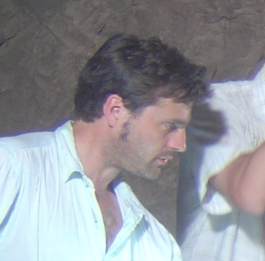1992, Uganda, East Africa.
Seated along with my brother atop stacks of doors in the back of a Bedford Ruwenzori mountains, the fabled “Mountains of the Moon” to Europeans. A junction with a few structures came into view ahead where the road headed toward the border with Zaire
My eyes took a moment to adjust from staring off at the mountains to focus on what lay in her palm. It was a hologram. Someone had neatly cut the eagle “security feature” out of a credit card and carefully and symmetrically rounded the edges. The new object was the size of a fingernail. In surprise I blurted out an American answer “oh... it’s just part…” She made a gesture with her other hand outlining the non-existent card perimeter, sighing a bit. My mind sped to reconstructing what may have been going on- she was trying to “sell” the object and had apparently been made aware in prior attempts that it was a fragment. Someone else must have obtained the card, trimmed it to just the hologram and likely pawned it off on this woman with explanations of its immense value. She probably was taken by the object’s physical properties and was persisting in attempts to sell it based on its somewhat miraculous image.
There are numerous themes entangled in the question “Does this have any value?” To whom? My short answer doesn’t even begin to address them. The woman perhaps was left wishing she had the remainder of the card, but the card still has no value in its materiality, it simply records a number, which itself has no intrinsic value, just a use as a link in a payment scheme.
Arthur C. Clark has been famously quoted from Profiles of The Future; “Any sufficiently advanced technology is indistinguishable from magic.” I recall my own wonder when I first saw a hologram. There was a window of time inAmerica
A related story: I was asked to design fancy paintjobs for a set of toy cars. Stores contemplating the cars decided a more expensive “deluxe” version should be added to the assortment. The toy company solution was to vacuum-plate the cars with iridescent chrome to increase their “perceived value”. While not a hologram, the optical refraction of light is similar in its artificial shifting rainbow of colors. As the designer of the originals, I was asked my opinion of the chrome cars. Perhaps the spread of credit card holograms had done its damage: I didn’t think the cars justified the increased cost. But more intangibly, the original little cars with their bright, glossy paint suddenly looked so dull and old-fashioned in comparison. The iridescence had little value in itself but it cannibalized the value of everything non-iridescent around it. From this standpoint that little hologram inAfrica was horrifying in the way it turned a lush landscape into a dull backdrop against its flashiness. It was less than value-less to me; it actually devalued its surroundings.
My eyes took a moment to adjust from staring off at the mountains to focus on what lay in her palm. It was a hologram. Someone had neatly cut the eagle “security feature” out of a credit card and carefully and symmetrically rounded the edges. The new object was the size of a fingernail. In surprise I blurted out an American answer “oh... it’s just part…” She made a gesture with her other hand outlining the non-existent card perimeter, sighing a bit. My mind sped to reconstructing what may have been going on- she was trying to “sell” the object and had apparently been made aware in prior attempts that it was a fragment. Someone else must have obtained the card, trimmed it to just the hologram and likely pawned it off on this woman with explanations of its immense value. She probably was taken by the object’s physical properties and was persisting in attempts to sell it based on its somewhat miraculous image.
There are numerous themes entangled in the question “Does this have any value?” To whom? My short answer doesn’t even begin to address them. The woman perhaps was left wishing she had the remainder of the card, but the card still has no value in its materiality, it simply records a number, which itself has no intrinsic value, just a use as a link in a payment scheme.
Arthur C. Clark has been famously quoted from Profiles of The Future; “Any sufficiently advanced technology is indistinguishable from magic.” I recall my own wonder when I first saw a hologram. There was a window of time in
A related story: I was asked to design fancy paintjobs for a set of toy cars. Stores contemplating the cars decided a more expensive “deluxe” version should be added to the assortment. The toy company solution was to vacuum-plate the cars with iridescent chrome to increase their “perceived value”. While not a hologram, the optical refraction of light is similar in its artificial shifting rainbow of colors. As the designer of the originals, I was asked my opinion of the chrome cars. Perhaps the spread of credit card holograms had done its damage: I didn’t think the cars justified the increased cost. But more intangibly, the original little cars with their bright, glossy paint suddenly looked so dull and old-fashioned in comparison. The iridescence had little value in itself but it cannibalized the value of everything non-iridescent around it. From this standpoint that little hologram in


0 Comments:
Post a Comment
<< Home